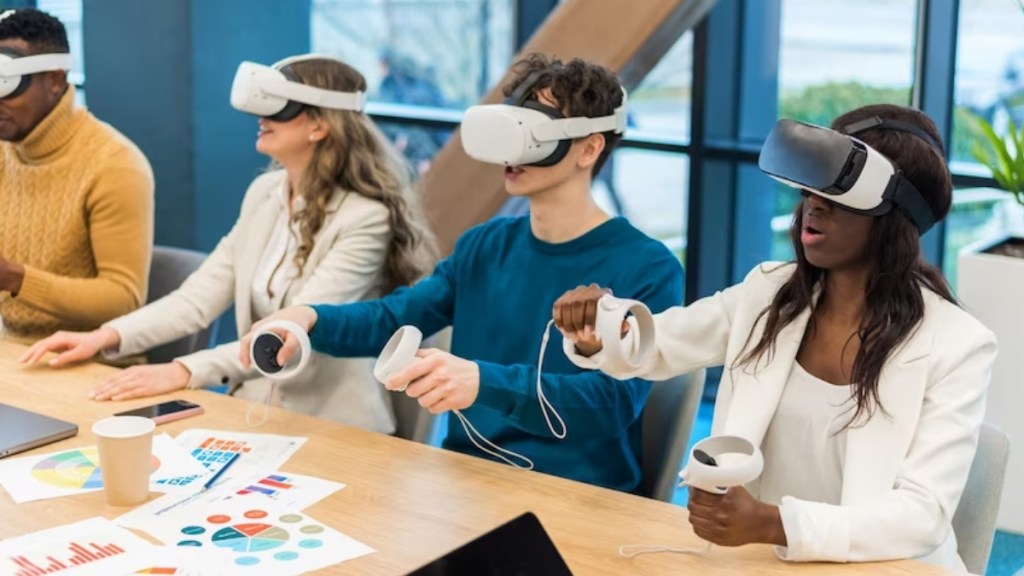By Devicharan R
Advancements in science and technology have significantly transformed the landscape of education. Specifically, emerging groundbreaking technologies such as augmented reality (AR) and virtual reality (VR) have revolutionised the way we engage in learning activities and even our learning environments. Because these technologies foster immersive experiences, they can enhance traditional learning methods and pave ways to nurture problem-solving skills amongst students – both undergraduate and those who are pursuing higher education after working for a few years.
The role of AR and VR




These technologies offer educators innovative ways to deliver content and engage students so that they can have a better learning experience. In AR, the digital content is overlayed onto the real-world scenarios, and this provides an immersive experience of virtual objects in the real world. For example, a teacher can use an AR app to demonstrate a volcanic eruption while teaching geography or geology or even to teach how volcanic eruptions can impact air routes. Such AR technologies promote active learning.
VR technology, on the other hand, offers a completely virtual environment – for example, virtual field trips, foreign language acquisition or virtual laboratories. These technologies when adopted in educational domain offers an enhanced hands-on experience which were never witnessed within the traditional classroom.
Benefits of immersive tech
Enhancing problem-solving skills: A major advantage of adoption of immersive technologies in the education domain is it improves problem-solving skills in students. It also facilitates opportunities to think critically, collaborate with peers, and to develop innovative solutions. For example, while using AR apps, it has been seen that students can seamlessly overlay virtual elements on to real-world objects, and learn in a much better way than they would have just from books or tablets. VR technologies, on the other hand, help students simulate and visualise hypothetical situations where they can experiment using scientific principles to address, let’s say, an environmental issue or engineer solutions to any complex problem.
Fostering immersive learning experiences: Traditional learning methods often struggle to capture the attention of today’s digital-native students. AR and VR technologies offer a solution by providing immersive learning experiences that cater to their learning styles. Through VR simulations, students can explore historical events, visit far-flung locations, or even travel through the human body, making learning more engaging and memorable. AR applications can bring textbooks to life, allowing students to interact with 3D models or access supplementary information by simply pointing their devices at designated markers. These immersive experiences not only deepen students’ understanding of the subject matter, but also spark curiosity and enthusiasm for learning.
Promoting collaborative learning: Collaboration is a vital skill in the modern workforce, and AR and VR technologies facilitate collaborative learning experiences within the classroom. By connecting students in virtual environments, regardless of physical distance, these technologies enable teamwork and peer-to-peer interaction. For instance, students can collaborate on group projects within a shared VR space, brainstorming ideas, and solve problems together in real time. Additionally, AR applications can support collaborative learning by allowing students to annotate and manipulate virtual objects collaboratively, fostering communication and teamwork skills essential for success in the digital age.
Challenges and considerations
While the potential of AR, VR and other emerging technologies in education is vast, their integration into the classroom is not without challenges. Limited access to technology, concerns about cost, and the need for teacher training are significant barriers that must be addressed to ensure equitable access to immersive learning experiences. Moreover, issues related to data privacy, digital citizenship, and screen time management require careful consideration to harness the full benefits of these technologies while mitigating potential risks.
The rise of AR, VR and other immersive technologies represents a paradigm shift in education, offering educators powerful tools to enhance traditional learning methods and cultivate essential skills in students. By leveraging these technologies, educators can empower students to thrive in an increasingly complex and interconnected world. As technology continues to evolve, embracing innovative approaches to education will be crucial in preparing students for success in the digital age and beyond.
The author is assistant professor (senior scale), department of media technology, Manipal Institute of Technology, MAHE






















